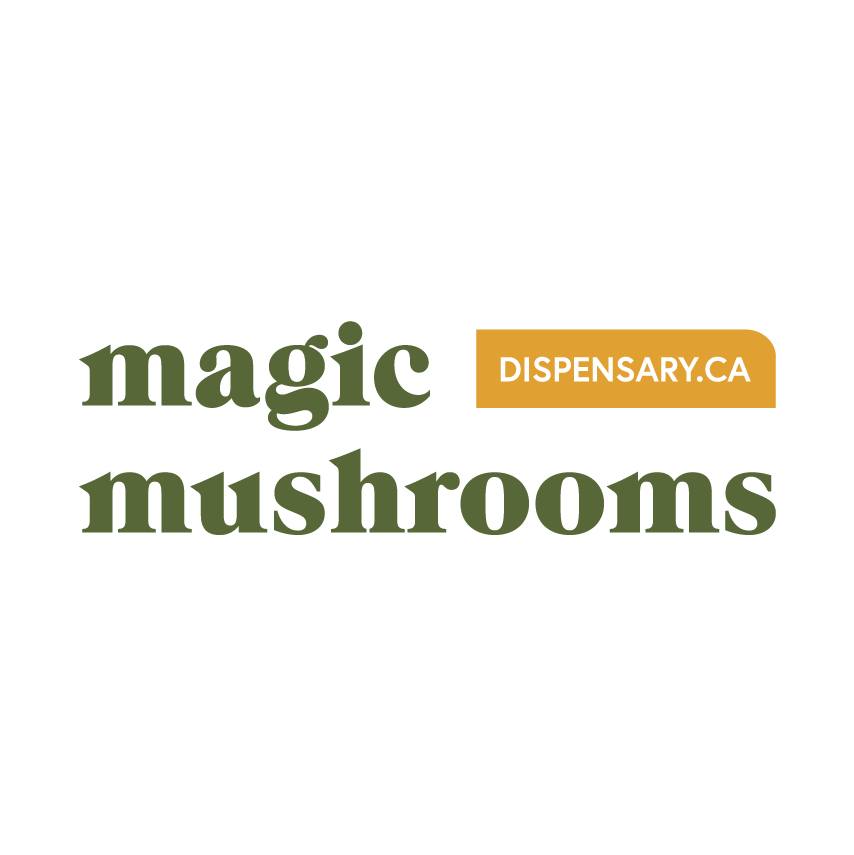The White Rabbit mushroom strain is an exceptional variety that originates from Holland. This strain, known as the White Rabbit, is recognized for its pure white appearance and high yield – a trait that cultivators cherish. Renowned for fostering intense visual, euphoric, and spiritual experiences, the White Rabbit strain attracts seekers of profound hallucinogenic journeys. Its unique moniker, ‘White Rabbit,’ is derived from its resemblance to rabbit fur, which reflects its potency and allure. Cultivating these mushrooms requires particular attention to environmental factors and temperature conditions. Delving further, one would uncover more about its cultivation process, nutritional profile, and prospects in psychotherapy.
Key Takeaways
- The White Rabbit Mushroom Strain is a hybrid from Holland, developed from Albino Penis Envy and Moby Dick, known for its white appearance and high potency.
- It thrives in a temperature range of 22-24 degrees Celsius and requires meticulous attention to environmental factors for optimal growth.
- Harvesting occurs when the veil under the cap breaks, and post-harvest care includes drying and storing in a cool, dark place for extended shelf life.
- White Rabbits contain 1.4-1.6% tryptamine, essential minerals, and high protein, and they’re known for potential health benefits, including aiding mental health disorders.
- Prospects include advancements in cultivation techniques, potential applications in psychotherapy, and ongoing efforts towards decriminalization in certain regions.
Understanding the White Rabbit Mushroom
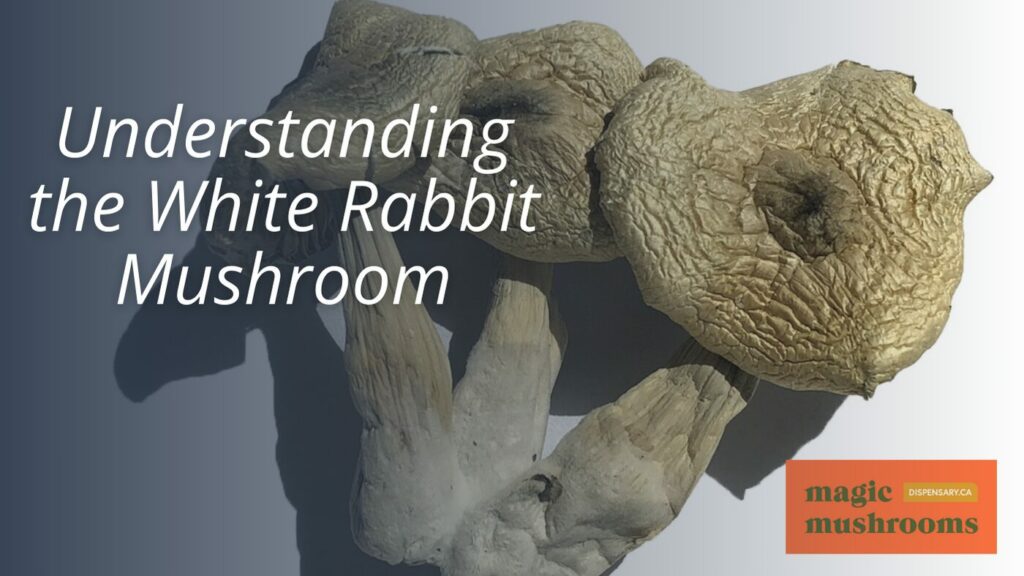
The White Rabbit Mushroom, a distinctive hybrid strain meticulously developed in Holland, is a remarkable blend of the Albino Penis Envy and Moby Dick, inheriting high potency and unique characteristics from both parent strains. This white rabbit mushroom strain is a testament to the prowess of Dutch mycologists, who, through their rigorous selection and breeding processes, have managed to create a strain that combines the best traits of its parents. It is also a testament to the power of hybridization in mycology.
The white rabbit strain is an entirely white mushroom with short, fat stems and a fuzzy appearance resembling a rabbit’s fur. This unique physical attribute and high potency make the White Rabbit an attractive choice for enthusiasts and cultivators. The strain exhibits a high yield, making it a preferred choice for commercial and home-based cultivators. Blue bruising may occur when dried, caused by psilocybin reacting with the air, but this does not affect the safety or potency of the strain.
The potency of the white rabbit mushroom strain is known to induce intense visual, euphoric, and spiritual experiences. This, coupled with its unique physical attributes and high yield, make it a strain of choice for those seeking liberation through the use of psychedelic mushrooms. Through its unique blend of potency and physical characteristics, the White Rabbit strain embodies the possibilities of liberation through mycology.
Origins of the White Rabbit Strain
Born out of diligent experimentation by Dutch mycology students, the White Rabbit strain stands as a testament to the power of hybridization, fusing the unique characteristics of Albino Penis Envy and Moby Dick mushrooms. The aim was to create a strain that would be visually appealing and offer high potency and a unique sensory experience.
The outcome was a mushroom strain that inherited the best traits from its parents: the Albino Penis Envy’s potency and the Moby Dick’s ease of cultivation. The White Rabbit strain, adorned with an entirely white appearance from stem to the cap, quickly became a favorite among mycology enthusiasts for its remarkable yield and beautiful discoloration.
The growing conditions for this strain also contribute to its popularity. They thrive best in a temperature range of 22-24 degrees Celsius within a mini greenhouse environment that ensures adequate humidity. These conditions have proven to stimulate optimal mushroom production.
Known for inducing vivid hallucinations, euphoria, and mystical experiences, the White Rabbit strain offers a unique psychedelic journey that caters to a variety of dose experiences—these range from microdosing for subtle effects to mega doses for a more intense and immersive experience.
The White Rabbit strain is a beacon of the endless possibilities within mycology’s realm. Its origins in Dutch experimentation underscore the importance of persistent research and innovation in creating strains that offer liberation and cater to the diverse needs of psychedelic enthusiasts worldwide.
The Mushroom’s Unique Name
Intriguingly, the name ‘White Rabbit’ is derived from the mushroom strain’s utterly white appearance, reminiscent of a rabbit’s fur, reflecting both its genetic lineage and the potent effects it can induce. This moniker is not just a whimsical choice; it is a fitting descriptor for a strain that embodies the essence of liberation and exploration often associated with mycology. The pale hue is an inheritance from its parent strains, Albino Penis Envy and Moby Dick, each contributing to the mushroom’s unique physical characteristics and potent biochemical profile.
The name ‘White Rabbit’ also alludes to the transformative experience that the strain can offer, much like the rabbit in Lewis Carroll’s “Alice in Wonderland” that leads Alice on her extraordinary journey. It is a mushroom strain that promises an enchanting expedition beyond the ordinary, inviting you to explore the depths of your consciousness and discover new perspectives.
Moreover, the ‘White Rabbit’ name signifies the mushroom’s uniqueness in mycology. Unlike other strains, the White Rabbit is distinguished not only by its physical attributes but also by its potent effects when consumed. The journey it invites you on is one of profound introspection and heightened perceptual awareness, opening doors to uncharted realms of consciousness.
Identifying the White Rabbit Mushroom
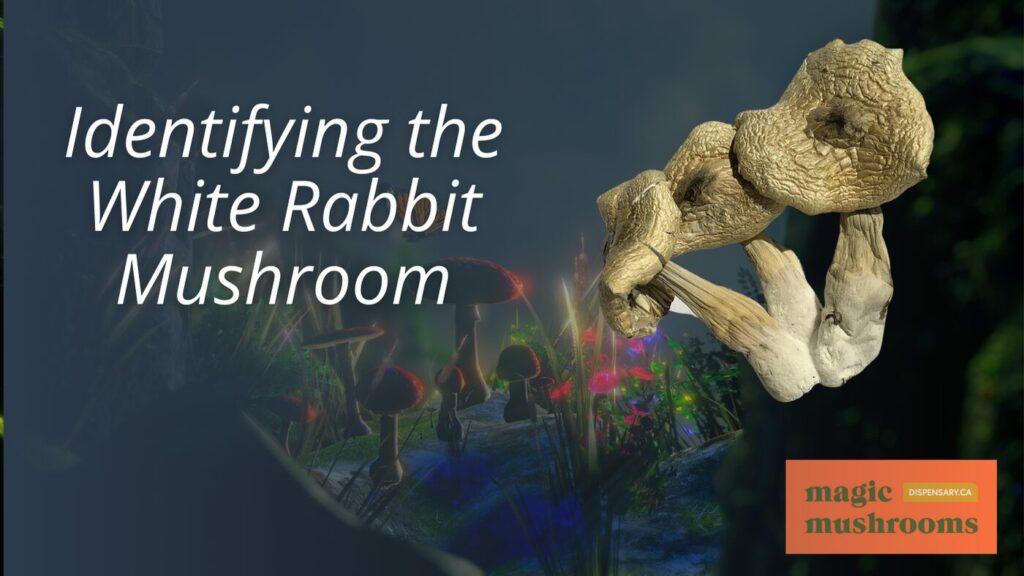
After understanding the unique naming of the White Rabbit mushroom, we can now explore the key distinguishing features that make it recognizable among other mushroom strains. This mushroom strain is a hybrid of the Albino Penis Envy and Moby Dick strains, combining the best characteristics of both, resulting in a mushroom with high potency and distinctive visual appeal.
The identifying features of the White Rabbit mushroom strain are its white stems and ivory caps, which give it an appearance reminiscent of a rabbit’s fur. This unique white coloration sets it apart from many other strains. When dried, these mushrooms bruise blue, another unusual characteristic that aids identification. Therefore, the mushroom’s appearance is appealing and serves a practical purpose in distinguishing it from other varieties.
Further, the White Rabbit mushroom strain contains a high tryptamine content of 1.4-1.6%. This high potency makes it a sought-after strain for those seeking a more intense experience. These mushrooms are known for inducing vivid hallucinations and a sense of euphoria, making them popular among those who desire liberation from the constraints of ordinary perception.
Cultivating White Rabbit Mushrooms
Cultivating the White Rabbit mushroom strain, revered for its high potency and striking appearance, requires meticulous attention to environmental factors and specific cultivation accessories for optimal yield. Originating in Dutch mycology, this hybrid variety combines the best traits of the Albino Penis Envy and Moby Dick strains. The resulting product is a mushroom that offers high yields and exhibits an enchanting discoloration, enticing the eye of many mycology enthusiasts.
Efficient cultivation of the White Rabbit mushroom requires a mini greenhouse. This accessory provides the high humidity levels necessary for the mushroom to thrive. Maintaining a steady temperature range between 22 and 24 degrees Celsius is crucial for optimal growth. A heating pad can be invaluable to ensure this temperature range, especially during cooler months. These accessories are designed to create the perfect environment for the White Rabbit mushroom, guaranteeing a consistent and high-quality yield.
The White Rabbit mushroom’s unique genetic heritage, classified as a hybrid variety by Tatandi, makes it a top choice for those seeking a potent and visually appealing strain. It’s not just about the high yield but also about the experience of cultivating something beautiful and powerful. Cultivating White Rabbit mushrooms is a journey of discovery, understanding the delicate balance of nature, and harnessing it to create something awe-inspiring. With the right tools and attention to detail, you will be well on your way to mastering the art of cultivating the White Rabbit mushroom strain.
Ideal Growth Conditions
Creating an environment mimicking the White Rabbit mushroom strain’s ideal growth conditions is essential to successfully cultivating it. This strain flourishes best in a mini greenhouse where humidity levels can be accurately controlled. It is recommended that growers maintain a stable and consistent environment, as fluctuations may disrupt the growth process, potentially reducing yield and potency.
The ideal temperature range to facilitate the growth of the White Rabbit strain is between 22 and 24 degrees Celsius. This temperature range is crucial to stimulating the development of the mycelium, the essential part of the mushroom responsible for nutrient absorption. During colder seasons, a heating pad can prove beneficial in maintaining this ideal temperature range.
Additionally, the White Rabbit strain requires a sterile environment for optimal growth. This is achieved by thoroughly cleaning and sterilizing all equipment and surfaces before introducing the mycelium. This precautionary step reduces the risk of contamination, ensuring the health and quality of your crop.
Regarding substrates, rye grain is often the preferred choice for cultivating the White Rabbit strain. Rye grain is nutrient-dense and retains moisture well, providing the mycelium with the nourishment it needs to thrive.
Challenges in Cultivation
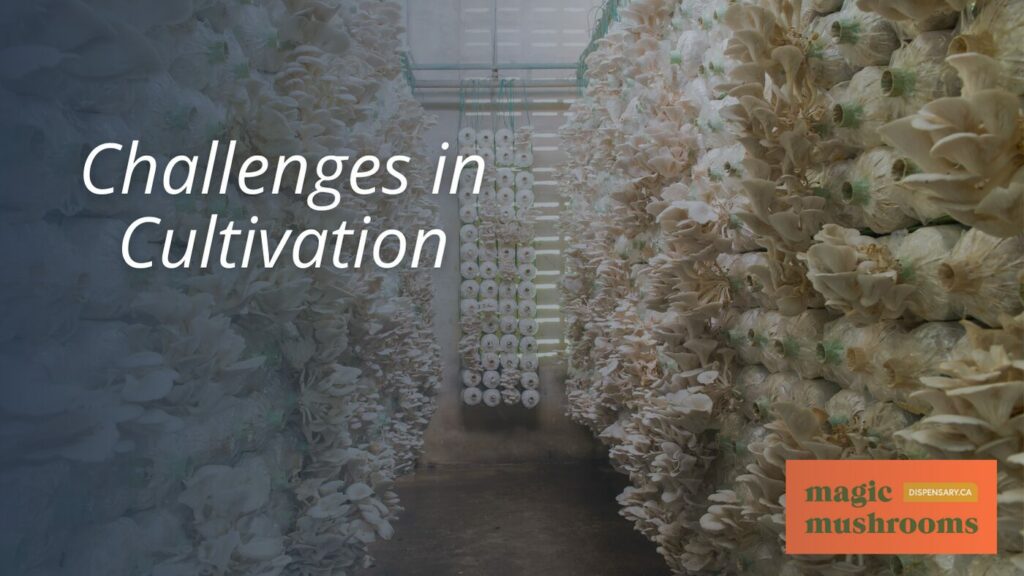
Despite its allure, the cultivation of the White Rabbit mushroom strain presents a unique set of challenges, primarily due to its hybrid nature and susceptibility to aborts and contamination. This strain is a marriage between Albino Penis Envy and Moby Dick, inheriting both their strengths and weaknesses. As such, the cultivation process requires meticulous care and attention to detail.
The White Rabbit mushroom thrives under specific conditions; deviations can lead to contamination or aborts. Its optimal growth environment necessitates sterilization and rye grain as a substrate. This level of precision can be daunting for those new to mycology, making the White Rabbit a strain often recommended for more experienced growers.
Moreover, this strain’s rarity and specific growing requirements can lead to stock-level fluctuations, posing another challenge for cultivators. The demand for this potent and visually appealing mushroom often exceeds the supply, adding an element of unpredictability to its cultivation.
The cultivation of the White Rabbit, while demanding, is not impossible. With the proper knowledge and resources, one can navigate these challenges and successfully cultivate this unique strain. However, it’s crucial to understand that this strain’s cultivation, due to its hybrid nature, is more complex compared to other strains. This understanding, coupled with patience and precision, will empower cultivators to embrace the challenges of growing the White Rabbit mushroom strain, transforming them from obstacles to stepping stones on their journey toward liberation through mycology.
Harvesting the Mushroom
Achieving a successful and potent yield from the White Rabbit mushroom strain hinges on proper harvesting techniques and optimal storage conditions. Harvesting this strain requires precision and understanding the mushroom’s growth cycle. Breaking the veil under the mushroom cap is the key indicator of when it is time to harvest. This is the stage at which the White Rabbit mushroom has reached its peak potency and maturity.
To harvest, use clean, sharp scissors to cut the mushrooms at the base of the stem. This ensures easy harvesting and minimizes the risk of damaging the mycelium, which could hinder future growth. Maintaining a high standard of cleanliness during the harvesting process is essential to avoid the introduction of contaminants, thus preserving the integrity and potency of the mushrooms.
Once harvested, the mushrooms should be stored in a cool, dark place. This helps to preserve their potency and prevents degradation. Depending upon individual requirements, White Rabbit mushrooms can be dried for long-term storage or consumed fresh for immediate effects. Drying the mushrooms extends their shelf life and allows for their convenience of usage at any desired time.
Mastering the art of harvesting ensures the successful cultivation of the White Rabbit mushroom strain, leading to a potent psychedelic experience. It requires patience, precision, and understanding the mushroom’s lifecycle. With careful harvesting and appropriate storage, one can harness the full potential of this unique strain, opening the door to newfound liberation.
Post-Harvest Mushroom Care
After successfully harvesting the White Rabbit mushrooms, appropriate post-harvest care is imperative to maintain the strain’s potency and freshness. A delicate balance of care can preserve this strain’s unique characteristics and properties.
Start by storing harvested mushrooms in a cool, dark place. This mitigates the risk of degrading the psilocybin content, a compound responsible for the strain’s high potency. Direct exposure to sunlight or heat can accelerate the decomposition process, diminishing the quality and potency of the mushrooms. Thus, keeping them from such conditions is a crucial aspect of post-harvest care.
Next, ensure that the mushrooms are thoroughly dried before storage. The drying process is vital as it prevents mold growth on the mushrooms, a common issue due to residual moisture. An adequately dried White Rabbit mushroom can be stored for extended periods without losing its potency, allowing for a consistent supply over time.
Culinary Uses of White Rabbit
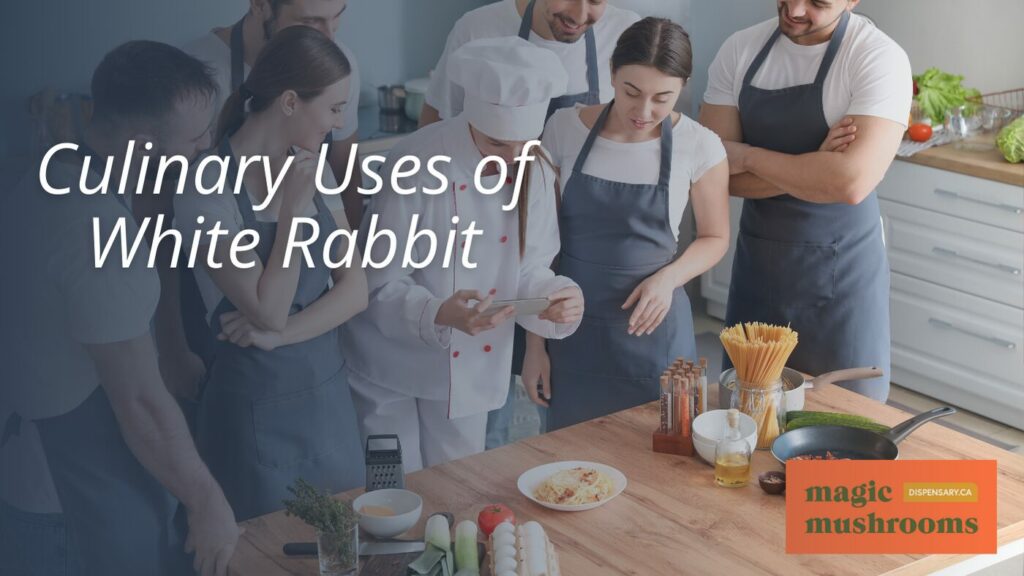
The versatility of White Rabbit mushrooms extends beyond cultivation and into the culinary realm, where they are often incorporated into various dishes to enhance both flavor and the dining experience. This strain, a crossbreed of Albino Penis Envy and Moby Dick, offers a unique blend of traits that make it a favorite among culinary enthusiasts seeking to add a dash of the extraordinary to their meals.
Drying is the most common method employed to maximize the potency and extend the shelf life of White Rabbit mushrooms. Once dried, these mushrooms can be ground into a fine powder, providing a convenient medium for incorporation into various recipes. This powdered form is suitable for creating infused chocolates or adding a twist to traditional soups and stews.
When exploring the culinary uses of White Rabbit mushrooms, it is essential to bear in mind the potential loss of potency when exposed to high temperatures. To preserve their psychedelic effects, it is recommended to employ cooking methods involving lower heat. An example is mushroom tea brewing, which provides a unique flavor and an enhanced dining experience.
In pursuing liberation through culinary exploration, the White Rabbit mushroom strain offers many opportunities. Whether you prefer the soothing warmth of mushroom-infused tea, the rich complexity of a stew, or the sweet indulgence of infused chocolates, White Rabbit mushrooms are a versatile ingredient that can elevate your dining experience to new heights.
Flavor Profile and Texture
Delving into the flavor profile and texture of the White Rabbit mushroom strain reveals a mild taste that is easy on the stomach, accompanied by a unique fuzzy texture reminiscent of a rabbit’s fur. This subtle gastronomic profile makes it suitable for those new to mushroom consumption. The mild flavor allows for a comfortable culinary experience devoid of overwhelming or nauseating aftertastes, which might deter enthusiasts from further exploration.
White Rabbit mushrooms are visually intriguing, with a fuzzy exterior that resembles their namesake, the rabbit. This texture contributes to their visual appeal and enhances the overall culinary experience. The fuzzy texture, unusual in the mushroom universe, contrasts the typical smooth or slimy surfaces.
Further enhancing its allure, the White Rabbit strain exhibits blue bruising when dried. This phenomenon, a response to psilocybin reacting with the air, does not compromise the mushroom’s safety or potency. Instead, it adds to its visual appeal and can serve as an indicator of its psilocybin content.
The White Rabbit mushroom strain offers a pleasant, mild flavor that complements its unique texture, making it an exciting choice for mycology enthusiasts. It embodies the potency of its parent strains, Albino Penis Envy and Moby Dick, in a package that is visually appealing and easy on the palate—the White Rabbit mushroom strain is truly a feast for both the eyes and the taste buds.
Popular White Rabbit Recipes
Building upon the White Rabbit mushroom strain’s unique flavor profile and textural appeal, many recipes incorporate this intriguing variety to elevate the culinary experience. These recipes harness the strain’s distinctive earthy flavor, complementing and enhancing various dishes, from soups and stir-fries to pasta creations.
One popular recipe involves adding sliced White Rabbit mushrooms to a classic cream of mushroom soup. Their earthy taste adds depth to the soup, while their remarkable texture provides a satisfying bite. Similarly, stir-fry enthusiasts often incorporate White Rabbits into their dishes. The heat of the wok brings out the rich flavors of the mushrooms, which blend harmoniously with other ingredients, such as peppers, onions, and a hint of soy or teriyaki sauce.
For pasta lovers, a simple spaghetti aglio e olio, traditionally made with garlic and olive oil, can be elevated by sautéing White Rabbit mushrooms before adding the garlic. This allows the mushrooms to release their unique flavor into the oil, infusing the entire dish with their earthy goodness.
The versatility of the White Rabbit strain allows for endless experimentation in the kitchen. Each cooking method can reveal a new facet of its flavor, making this strain a valuable ingredient in any culinary repertoire. Whether you’re a seasoned chef or a curious home cook, the White Rabbit strain offers an opportunity to unleash creativity, enrich dishes, and redefine the boundaries of flavor.
Nutritional Profile of White Rabbits
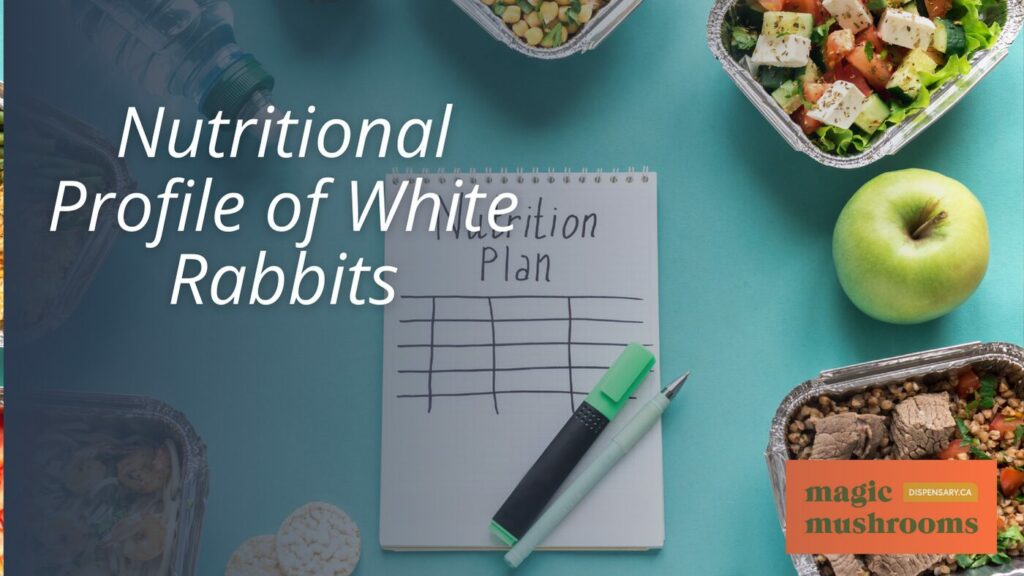
In assessing the nutritional profile of White Rabbit mushrooms, it’s important to note that their unique composition, which includes an average of 1.4-1.6% tryptamine content, sets them apart from other strains. This significant concentration of tryptamine, a naturally occurring compound in many plant and animal species, contributes to the psychoactive properties of this mushroom strain. However, the nutritional value of these fungi extends far beyond their psychoactive constituents.
Like most mushrooms, White Rabbits are low in calories and fat while high in fiber, making them a healthy addition to your diet. They also contain essential minerals such as potassium, zinc, and magnesium, contributing to overall bodily function and wellbeing. Notably, they are rich in B vitamins, including niacin and riboflavin, which play vital roles in energy production and DNA repair.
Furthermore, these mushrooms exhibit a higher protein content than other vegetable sources, indicating their nutritional density. As a complete protein source, they provide all nine essential amino acids that the body cannot produce independently. This makes them a precious food source for those following plant-based diets.
It’s worth mentioning that the White Rabbit mushrooms’ unique white stems and ivory caps, which bruise blue, are visually striking and indicate their potent antioxidant properties. Antioxidants help combat oxidative stress in the body, promoting overall health and longevity.
Therefore, the White Rabbit mushroom strain offers a complex and beneficial nutritional profile beyond its psychoactive properties. This makes it a nutritious and intriguing addition to the diets of those seeking to explore new culinary landscapes and health horizons.
Potential Health Benefits
While the nutritional profile of White Rabbit mushrooms provides a compelling reason for their consumption, these mushrooms also promise an array of potential health benefits, particularly in mental health. Their psilocybin content has shown promise in treating mental health disorders such as depression and anxiety. Psilocybin-assisted therapy, utilizing strains like White Rabbit, is heralded as a breakthrough in mental health treatment due to its therapeutic potential.
Moreover, the trend of microdosing White Rabbit mushrooms is backed by ongoing research suggesting benefits such as enhanced creativity and problem-solving skills. This is a liberating prospect for individuals seeking cognitive enhancement and personal development. The ability of these mushrooms to induce spiritual experiences and introspection can also lead to emotional release, providing a pathway to self-discovery and inner peace.
Furthermore, studies indicate that White Rabbit mushrooms could enhance mood, cognition, focus, and mindfulness. These properties aid personal growth, mental clarity, and overall emotional wellbeing. As we embrace the future of mental health therapies, the White Rabbit mushroom strain emerges as a potent tool for stimulating positive psychological change.
Understanding Mushroom Allergies
Rarely discussed yet significant, mushroom allergies can manifest in individuals sensitive to particular species or proteins found in mushrooms. The symptoms can vary from mild to severe, depending on one’s sensitivity level and the type of mushroom consumed.
While uncommon, these allergies can cause discomfort and even severe reactions. Mild symptoms include itching, hives, or a runny nose, which can be mistaken for common allergic reactions to dust or pollen. However, in more severe cases, individuals may experience anaphylaxis, a potentially life-threatening allergic reaction that requires immediate medical attention.
The proteins in mushrooms are the primary culprits of these allergic reactions. Mushrooms, a type of fungus, share common proteins with molds and other fungi. This similarity can lead to cross-reactivity, where individuals allergic to molds may also react adversely to mushrooms. Hence, if you’re sensitive to mold or have a known mushroom allergy, you must be cautious when consuming new mushroom strains, such as the White Rabbit.
Notably, these allergies can be species-specific. That means a person allergic to one mushroom species may be able to consume another without any adverse reactions. This selective sensitivity makes it even more important to identify any specific mushroom allergies with the help of a healthcare provider.
Safety Concerns and Precautions

Despite their popularity among mycology enthusiasts, White Rabbit mushrooms carry specific safety concerns and precautions that need to be thoroughly understood and considered. While the White Rabbit strain is known for its high potency and visual appeal, it is also capable of triggering adverse effects, such as nausea and vomiting, in some users. Therefore, caution should be exercised, especially by those new to mycology or those with a sensitive constitution.
Importantly, individuals with a history of mental health issues are advised to avoid the consumption of White Rabbit mushrooms. The high potency of this strain could potentially trigger or exacerbate latent psychological conditions and should be considered a severe risk.
Adding to the complexity, the combination of White Rabbit mushrooms with other substances can significantly increase the likelihood of adverse reactions. For example, mixing these mushrooms with alcohol or other psychoactive substances can lead to unexpected and potentially dangerous effects.
Lastly, it’s crucial to be aware that the possession and distribution of White Rabbit mushrooms, like all psilocybin mushrooms, may have legal implications. In the United States, for instance, they are classified as Schedule I controlled substances. Legal consequences can arise in certain regions for those in possession or distributing this strain.
Understanding and respecting these safety concerns and precautions is fundamental to liberating oneself through exploring mycology. It encourages responsible use and promotes a safe, informed, and enriching experience with the White Rabbit mushroom strain.
Myths About the White Rabbit Strain
Various myths and misunderstandings surround the potent White Rabbit mushroom strain, often leading to misconceptions about its effects. One such myth suggests that consumption of these mushrooms can lead to permanent hallucinations or altered perceptions. However, this is far from the truth, as the effects of White Rabbit mushrooms, while potent, are temporary and wear off after a few hours.
Contrary to some sensationalized narratives, the White Rabbit strain does not possess the ability to cause long-term psychological disturbances. The effects largely depend on the dosage, individual tolerance, and mental state during consumption. This dispels the myth of permanent alterations to one’s mental state and perception.
In their quest for liberation and expanded consciousness, many individuals may misconstrue these myths as facts, leading to potential misuse or misunderstanding of the White Rabbit strain’s effects. It is crucial to differentiate between myths and factual information when discussing this strain.
The White Rabbit strain, a hybrid of Albino Penis Envy and Moby Dick, is indeed known for its potent effects. However, the impact is transient and manageable with responsible use. Misinformation only clouds the real benefits and experiences these mushrooms can offer.
White Rabbit in Folk Medicine
How is the White Rabbit mushroom strain featured in folk medicine traditions? This unique hybrid, a cross between Albino Penis Envy and Moby Dick, has been traditionally used in varying cultures for its potential therapeutic benefits. Its high potency and ease of cultivation made it a staple in the folk medicine arsenal.
The White Rabbit mushroom strain holds significant importance in mental health and wellbeing. Due to its reported mood-enhancing effects, folk medicine practitioners often incorporate this strain into their healing practices. The strain was used as a tool to alleviate symptoms of stress, anxiety, and depression, offering a potential pathway to mental liberation.
Moreover, the White Rabbit strain was revered for its supposed healing properties and used in spiritual practices in certain cultures. It was believed that this unique strain could foster a transformative experience, leading to personal growth and enlightenment. This mystical aspect of the White Rabbit was highly valued, further embedding its use in folk medicine traditions.
The White Rabbit mushroom was also leveraged to treat various physical and psychological ailments. Traditional healers utilized the strain’s high potency to address symptoms of physical discomfort, providing an alternative treatment method for those seeking relief outside conventional medicine.
The White Rabbit mushroom strain has a rich history within folk medicine. Its potent effects, ease of cultivation, and visually appealing characteristics have made it a revered component in traditional therapeutic practices, illustrating the strain’s multifaceted value in the quest for liberation.
Comparing White Rabbit With Other Strains
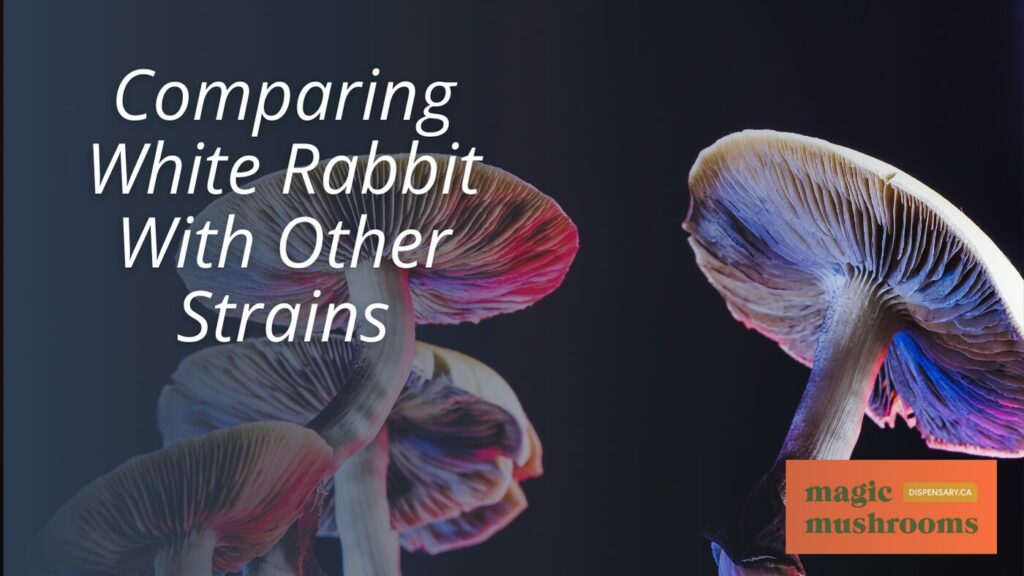
In the vast landscape of mushroom strains, the White Rabbit strain distinguishes itself through its unique genetic heritage and characteristics, warranting a comparison with other famous strains. Derived from a cross between the Albino Penis Envy and the Moby Dick strains, White Rabbit carries the potent genetic lineage of both, culminating in a strain that is both potent and visually impressive.
The Albino Penis Envy’s contribution to the White Rabbit’s genetic profile is readily apparent in its potent effects and intense visuals. This parent strain is renowned for its high potency, which White Rabbit inherits and amplifies. The resulting strain, therefore, offers a profound and intense experience, making it a top choice for those seeking a potent mushroom strain.
On the other hand, the Moby Dick strain brings balance to the White Rabbit’s profile. Known for its ease of cultivation, Moby Dick adds a layer of practicality to White Rabbit, making it ideal for both seasoned mycologists and beginners. Its contribution to White Rabbit’s genetic makeup ensures the strain is potent and accessible to various cultivators.
The White Rabbit’s unique combination of parent strains results in a mushroom variety that is both potent and visually appealing. Its distinct characteristics set it apart from other strains, adding diversity to the mushroom landscape. The fusion of high potency, stunning visuals, and cultivation ease makes the White Rabbit strain an attractive option in the expansive world of mushroom strains, providing a captivating choice for those desiring liberation through mycology.
Conserving the White Rabbit Strain
Maintaining the White Rabbit strain’s potent and visually impressive qualities requires mindful conservation strategies, including proper storage techniques. Careful handling and appropriate storage significantly extend the lifeline of these mushrooms, ensuring the preservation of their unique characteristics and potency.
White Rabbit mushrooms must be stored in a cool, dark place to retain their freshness and potency. Exposure to elements such as heat or moisture can significantly degrade the psilocybin content, the chemical compound responsible for the mushrooms’ psychoactive effects. Thus, storing these mushrooms in conditions that mimic their natural environment as closely as possible is crucial.
Additionally, airtight containers or vacuum-sealed bags are the preferred methods for storage. These methods prevent oxidation, an enemy of psilocybin, thus preserving the mushrooms’ potency over time. It is equally important to note that freezing these mushrooms is not recommended. Freezing can alter their texture and potency, leading to a less-than-optimal experience when consumed.
Properly conserving the White Rabbit strain can lead to a longer shelf life in line with these methods. Furthermore, it ensures that the effects experienced when consuming these mushrooms are optimal, providing the liberation many users seek.
Ultimately, the key to successfully conserving the White Rabbit strain lies in understanding and implementing these strategies. This strain’s potency and unique qualities can be preserved through mindful conservation, ensuring an enduring, superior experience for its users.
The Role of White Rabbit in Ecosystems
Have we ever wondered about the profound impact of White Rabbit mushrooms on our ecosystems? As organisms that break down organic matter, these fungi are indispensable in enriching the soil and contributing to nutrient cycling. They are vital decomposers, disassembling dead plant material and recycling nutrients back into the environment, which maintains the health of our forests and grasslands.
In their quiet, unassuming way, White Rabbit mushrooms sustain life. They support plant growth by releasing essential nutrients into the soil, helping maintain its structure and fertility. Their role in fostering a robust ecosystem is not limited to the botanical world. These mushrooms also provide nourishment and habitat for various organisms, contributing significantly to overall biodiversity.
White Rabbit mushrooms enrich our ecosystems and aid in mitigating climate change. They contribute to carbon sequestration, which involves capturing and storing atmospheric carbon dioxide. These mushrooms store carbon in the soil through their decomposition activities, helping to balance the carbon cycle and combat global warming.
White Rabbit and Soil Health
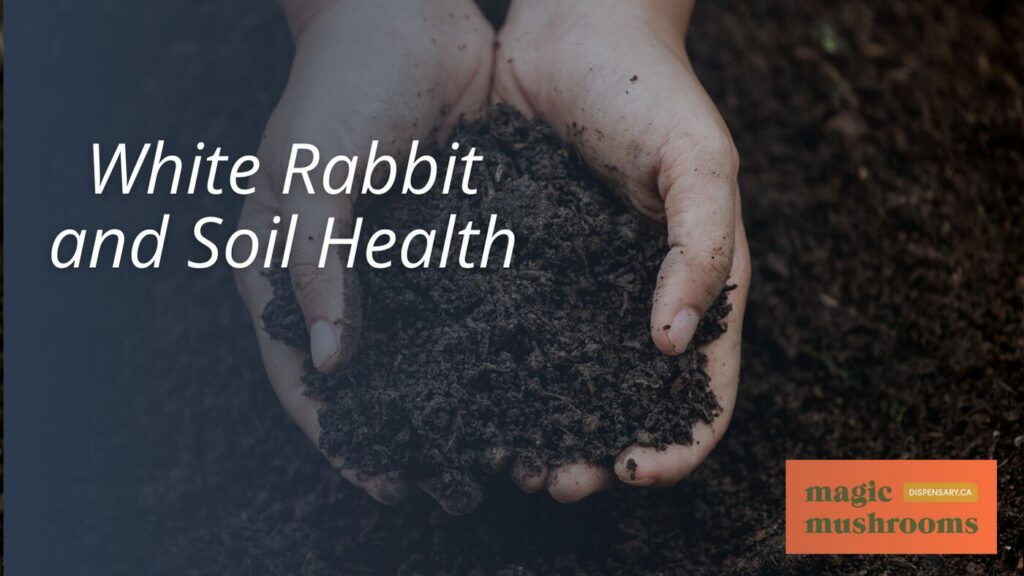
While the White Rabbit mushrooms significantly contribute to biodiversity and climate change mitigation, their growth and proliferation heavily depend on the soil’s health and quality. These fungi flourish in soil enriched with organic matter and nutrients, a testament to their affinity for well-nourished environments. Like many other mushroom strains, the White Rabbit prefers slightly acidic soil conditions, highlighting the importance of monitoring soil pH levels when cultivating this strain.
The ideal soil moisture levels for White Rabbit mushrooms are another crucial aspect of soil health. Excessive moisture can lead to waterlogging and root rot, hindering the growth and development of these mushrooms. Consequently, ensuring a well-draining soil structure is paramount for healthy White Rabbit populations.
Organic amendments such as compost or aged manure can help achieve soil fertility. These additions enrich the soil with essential nutrients and promote a thriving environment for White Rabbit mushrooms. This contributes to the sizeable yields and high potency for which this strain is celebrated.
The Future of White Rabbit Farming
The potential future of White Rabbit mushroom farming holds promise, underscored by the strain’s genetic propensity for high yields and its unique attributes that make it a highly desirable variety. The hybrid strain, a crossbreed between Albino Penis Envy and Moby Dick, boasts a potent and visually alluring product, attracting a growing community of mycology enthusiasts.
The evolution of White Rabbit farming is likely to involve advancements in cultivation techniques to maximize potency and yield. As optimal growth conditions inherently demand a temperature range of 22-24 degrees Celsius and a mini greenhouse environment with high humidity, there is potential for innovation in creating these conditions in various settings. This could potentially lead to the mushroom being farmed in diverse geographic locations, thus expanding its reach and accessibility.
The anticipated future of White Rabbit farming involves technical advancements and the rising demand and interest in psychedelic mushrooms. As awareness and acceptance of these mushrooms grow, the White Rabbit strain, with its distinctive characteristics and high yield, is positioned to become a top choice for enthusiasts and cultivators.
Innovative Uses of White Rabbit Mushrooms
Beyond their potential in agricultural advancements, White Rabbit mushrooms are gaining recognition for their innovative applications in mental health treatment. Recent studies reflect the prowess of this unique strain in effectively treating depression and anxiety, thereby positioning it as a powerful tool in psychotherapy. The potential therapeutic uses of these mushrooms are not confined to only mental health disorders; emerging research points towards their ability to enhance creativity and problem-solving skills, further broadening their application spectrum.
The interest surrounding White Rabbit mushrooms is propelled by their distinctive properties, which are being hailed as a breakthrough in mental health treatment. For instance, microdosing, the practice of consuming minimal amounts, is being extensively studied for its potential to deliver mental health benefits. This practice is believed to exert positive effects on emotional health without the intense psychedelic experiences associated with larger doses.
Another significant stride in the domain of White Rabbit mushrooms is the ongoing efforts towards their decriminalization in certain regions. These efforts highlight a collective desire for liberation, a shift from rigid legislative constraints towards a more open-minded stance on such potential mental health solutions. This progress is an encouraging sign of the mushroom’s impending wider acceptance and recognition.
Celebrating the White Rabbit Mushroom
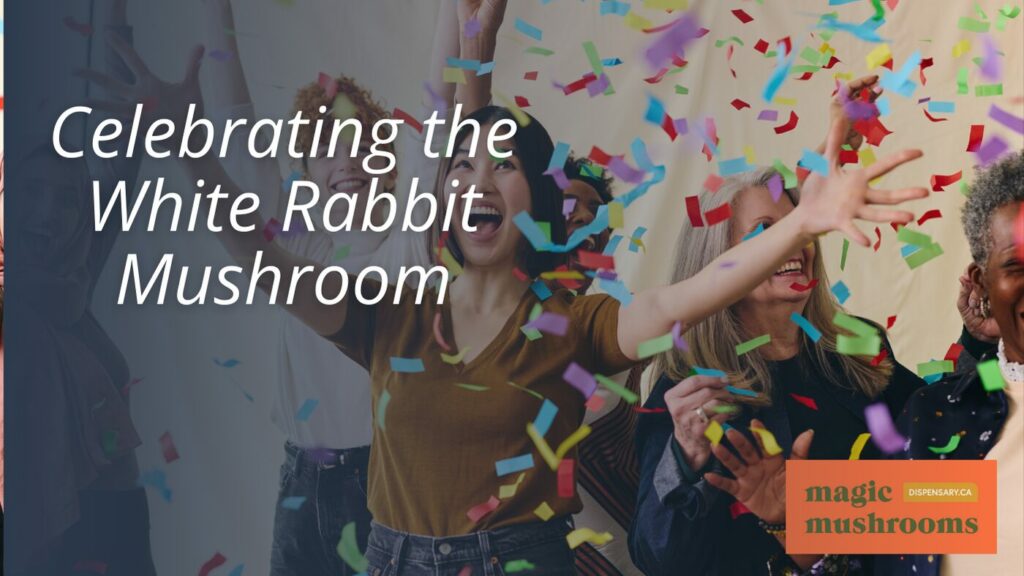
Esteemed for its striking aesthetics and potent effects, the White Rabbit Mushroom strain is hailed as a marvel within the mycology community. This particular strain, a hybrid of Albino Penis Envy and Moby Dick, features white stems and ivory caps that bruise blue, making it a visually captivating experience for both cultivators and consumers alike. Originating from the labs of Dutch mycology students, this strain has since captivated experienced psychedelic enthusiasts worldwide.
The celebration of the White Rabbit Mushroom goes beyond its enchanting appearance. Its potent effects, attributed to its high tryptamine content of 1.4-1.6%, make it a sought-after choice for those seeking liberation through altered perceptions and euphoria. These intense hallucinogenic effects have facilitated profound introspective journeys for many, opening new realms of consciousness and understanding.
Moreover, cultivating White Rabbit Mushrooms also allows growers to engage in a form of liberation. The simple joy of nurturing these fungi from spores to mature mushrooms provides a gratifying sense of accomplishment. The recommended growing conditions, such as maintaining a temperature range of 22-24 degrees Celsius and using a mini greenhouse with adequate humidity, make this strain accessible to novice and experienced cultivators.
Frequently Asked Questions
What Contributes to the White Rabbit Mushrooms High Potency?
The high potency of the White Rabbit Mushroom Strain is attributed to its unique hybrid genetics, derived from the cross between Albino Penis Envy and Moby Dick strains. These parent strains are known for their high psilocybin content, producing potent offspring. Additionally, optimal growing conditions, including temperature, humidity, and the use of a mini greenhouse, can enhance the strain’s potency. Therefore, genetic influences and meticulous cultivation methods contribute to this strain’s high potency.
How Does the White Rabbit Strain Differ From Its Parent Strains?
The White Rabbit strain primarily differs from its parent strains in potency and visual allure. It inherits high potency from the Albino Penis Envy and the trait of easy cultivation from Moby Dick. Additionally, it displays a unique discoloration that makes it visually appealing. Its high yield and adaptability to varying growing conditions distinguish it from its parent strains. The White Rabbit strain represents a dynamic amalgamation of its parent strains’ best traits.
Are There Any Specific Tools Needed for Cultivating White Rabbit Mushrooms?
Specific tools are essential to cultivate White Rabbit mushrooms. A mini greenhouse is recommended to create a controlled environment, with a thermometer to track the ideal temperature of 22-24 degrees Celsius. A hygrometer is needed to maintain humidity levels. You’ll also require a high-quality substrate for the mushroom mycelium to grow in and sterilization equipment to keep conditions sanitary. These tools aid in effectively cultivating this strain and optimizing its yield potential.
What Are the Risks Associated With Consuming Too Much White Rabbit Mushroom?
Due to its high potency, overconsumption of the White Rabbit Mushroom strain can lead to adverse effects. These may include nausea, disorientation, and hallucinations. In severe cases, it can result in poisoning, leading to more serious health complications. Therefore, it is crucial to consume this strain responsibly and in moderation. Always start with small doses, particularly for those new to consuming this type of mushroom.
Has the White Rabbit Mushroom Been Used in Any Scientific Research or Studies?
Scientific scrutiny of the White Rabbit mushroom strain is still in infancy. While anecdotal evidence abounds regarding its potent psychoactive properties, peer-reviewed research is limited. However, mushrooms of similar strains have been studied for potential therapeutic benefits, from mental health treatments to immune system support. Future research may reveal more about the White Rabbit strain’s unique properties and possible applications. Until then, its use is primarily confined to recreational and personal cultivation circles.
Conclusion
In conclusion, the White Rabbit Mushroom Strain, a unique hybrid from Dutch mycology, has captivated enthusiasts with its high yield potential and distinctive appearance. Its cultivation, which requires specific temperature and humidity conditions, contributes to its high potency. This particular white rabbit strain, with advances in farming techniques, holds considerable promise for the future. Moreover, a compelling statistic reveals that White Rabbit Mushroom Strain yields can be up to 50% higher than other strains, underscoring its appeal within mycology.
Buying Microdosing Mushrooms Online in Canada
Are you an avid microdoser or looking to venture into the art of microdosing? Working with a reliable, trustworthy shrooms dispensary is paramount in your journey of becoming a better version of yourself. Magic Mushroom Dispensary prides itself on its comprehensive collection of top-notch microdosing products, psilocybin books, excellent customer service, and fast, discreet shipping. Visit our online shop today and enjoy low prices and free shipping for orders above $99.
